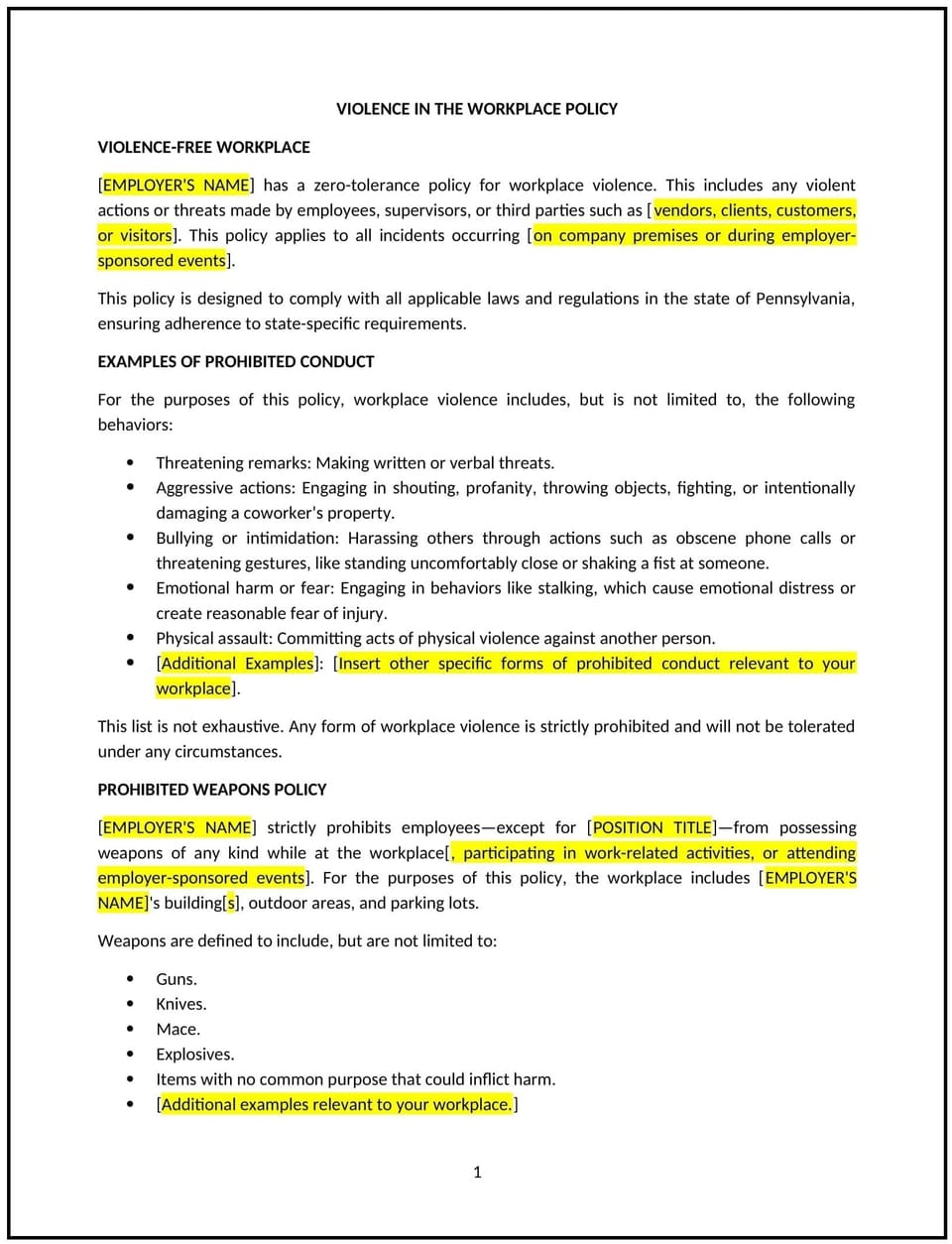Violence in the workplace policy (Pennsylvania): Free template

Violence in the workplace policy (Pennsylvania)
This violence in the workplace policy is designed to help businesses in Pennsylvania establish clear guidelines to prevent, identify, and address workplace violence. By defining unacceptable behaviors, outlining reporting procedures, and emphasizing safety measures, this template helps create a secure and respectful work environment for all employees.
By using this template, businesses can reduce risks, protect employees, and align with Pennsylvania and federal workplace safety regulations.
How to use this violence in the workplace policy (Pennsylvania)
- Define workplace violence: Clearly outline what constitutes violence, such as physical harm, threats, harassment, or intimidation.
- Include reporting procedures: Provide steps for employees to report incidents of workplace violence, including designated contacts and confidentiality protections.
- Address prevention measures: Specify actions the company will take to prevent violence, such as training, risk assessments, or workplace security protocols.
- Detail response protocols: Outline how the business will handle reports of violence, including investigations, support for affected employees, and disciplinary measures.
- Reflect Pennsylvania-specific considerations: Tailor the policy to address state laws and industry-specific safety requirements.
Benefits of using a violence in the workplace policy (Pennsylvania)
A well-structured violence in the workplace policy supports employee safety and workplace harmony. Here's how it helps:
- Promotes safety: Reduces risks by creating a proactive approach to identifying and addressing workplace violence.
- Enhances accountability: Establishes clear guidelines for reporting and addressing incidents, ensuring all employees understand their responsibilities.
- Supports compliance: Aligns with Pennsylvania labor laws and federal workplace safety regulations, minimizing legal risks.
- Improves employee trust: Demonstrates a commitment to employee well-being and a secure work environment.
- Reflects local needs: Addresses Pennsylvania-specific workplace safety challenges, such as industry-specific risks or regional workforce dynamics.
Tips for using a violence in the workplace policy (Pennsylvania)
- Communicate the policy: Share the policy with employees during onboarding and ensure it is accessible for ongoing reference.
- Train employees and managers: Provide training on identifying, preventing, and addressing workplace violence, tailored to the company’s specific risks.
- Conduct regular risk assessments: Periodically evaluate the workplace for potential risks and take preventive actions as needed.
- Offer support resources: Provide affected employees with access to counseling or other resources to help them recover from incidents.
- Review periodically: Update the policy to reflect changes in Pennsylvania laws, workplace practices, or risk factors.
Q: What behaviors are considered workplace violence under this policy?
A: Workplace violence includes physical harm, threats, harassment, intimidation, or any behavior that creates a hostile or unsafe work environment.
Q: How can employees report incidents of workplace violence?
A: Employees should report incidents to their manager, HR, or a designated contact following the procedures outlined in the policy.
Q: What preventive measures are included in this policy?
A: Preventive measures may include employee training, workplace risk assessments, and security enhancements to reduce the likelihood of incidents.
Q: How does the business respond to reports of workplace violence?
A: The business conducts a thorough investigation, supports affected employees, and takes appropriate disciplinary actions based on the severity of the incident.
Q: How does this policy benefit Pennsylvania businesses?
A: The policy helps Pennsylvania businesses reduce risks, support employee safety, and ensure compliance with state and federal workplace safety laws.
This article contains general legal information and does not contain legal advice. Cobrief is not a law firm or a substitute for an attorney or law firm. The law is complex and changes often. For legal advice, please ask a lawyer.


